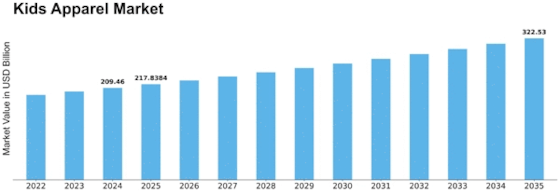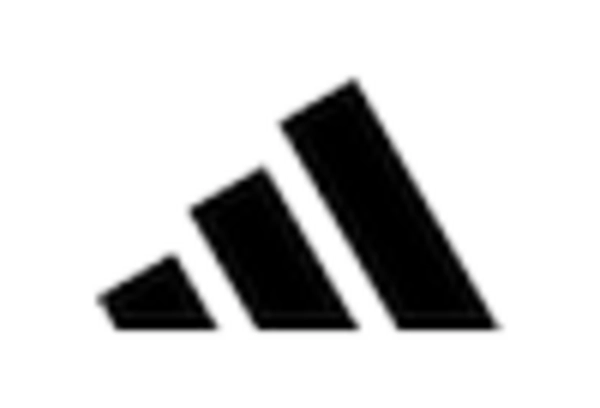- Kids Apparel Market By Product Type (USD Billion, 2019-2035)
- Tops
- Bottoms
- Outerwear
- Footwear
- Accessories
- Kids Apparel Market By Age Group (USD Billion, 2019-2035)
- Infants
- Toddlers
- Kids
- Pre-teens
- Teenagers
- Kids Apparel Market By Gender (USD Billion, 2019-2035)
- Kids Apparel Market By Distribution Channel (USD Billion, 2019-2035)
- Online Stores
- Department Stores
- Specialty Stores
- Supermarkets
- Discount Stores
- Kids Apparel Market By Regional (USD Billion, 2019-2035)
- North America
- Europe
- South America
- Asia Pacific
- Middle East and Africa
North America Outlook (USD Billion, 2019-2035)
North America Kids Apparel Market by Product Type
Tops
Bottoms
Outerwear
Footwear
Accessories
North America Kids Apparel Market by Age Group Type
Infants
Toddlers
Kids
Pre-teens
Teenagers
North America Kids Apparel Market by Gender Type
Boys
Girls
Unisex
North America Kids Apparel Market by Distribution Channel Type
Online Stores
Department Stores
Specialty Stores
Supermarkets
Discount Stores
North America Kids Apparel Market by Regional Type
US
Canada
US Outlook (USD Billion, 2019-2035)
US Kids Apparel Market by Product Type
Tops
Bottoms
Outerwear
Footwear
Accessories
US Kids Apparel Market by Age Group Type
Infants
Toddlers
Kids
Pre-teens
Teenagers
US Kids Apparel Market by Gender Type
Boys
Girls
Unisex
US Kids Apparel Market by Distribution Channel Type
Online Stores
Department Stores
Specialty Stores
Supermarkets
Discount Stores
CANADA Outlook (USD Billion, 2019-2035)
CANADA Kids Apparel Market by Product Type
Tops
Bottoms
Outerwear
Footwear
Accessories
CANADA Kids Apparel Market by Age Group Type
Infants
Toddlers
Kids
Pre-teens
Teenagers
CANADA Kids Apparel Market by Gender Type
Boys
Girls
Unisex
CANADA Kids Apparel Market by Distribution Channel Type
Online Stores
Department Stores
Specialty Stores
Supermarkets
Discount Stores
Europe Outlook (USD Billion, 2019-2035)
Europe Kids Apparel Market by Product Type
Tops
Bottoms
Outerwear
Footwear
Accessories
Europe Kids Apparel Market by Age Group Type
Infants
Toddlers
Kids
Pre-teens
Teenagers
Europe Kids Apparel Market by Gender Type
Boys
Girls
Unisex
Europe Kids Apparel Market by Distribution Channel Type
Online Stores
Department Stores
Specialty Stores
Supermarkets
Discount Stores
Europe Kids Apparel Market by Regional Type
Germany
UK
France
Russia
Italy
Spain
Rest of Europe
GERMANY Outlook (USD Billion, 2019-2035)
GERMANY Kids Apparel Market by Product Type
Tops
Bottoms
Outerwear
Footwear
Accessories
GERMANY Kids Apparel Market by Age Group Type
Infants
Toddlers
Kids
Pre-teens
Teenagers
GERMANY Kids Apparel Market by Gender Type
Boys
Girls
Unisex
GERMANY Kids Apparel Market by Distribution Channel Type
Online Stores
Department Stores
Specialty Stores
Supermarkets
Discount Stores
UK Outlook (USD Billion, 2019-2035)
UK Kids Apparel Market by Product Type
Tops
Bottoms
Outerwear
Footwear
Accessories
UK Kids Apparel Market by Age Group Type
Infants
Toddlers
Kids
Pre-teens
Teenagers
UK Kids Apparel Market by Gender Type
Boys
Girls
Unisex
UK Kids Apparel Market by Distribution Channel Type
Online Stores
Department Stores
Specialty Stores
Supermarkets
Discount Stores
FRANCE Outlook (USD Billion, 2019-2035)
FRANCE Kids Apparel Market by Product Type
Tops
Bottoms
Outerwear
Footwear
Accessories
FRANCE Kids Apparel Market by Age Group Type
Infants
Toddlers
Kids
Pre-teens
Teenagers
FRANCE Kids Apparel Market by Gender Type
Boys
Girls
Unisex
FRANCE Kids Apparel Market by Distribution Channel Type
Online Stores
Department Stores
Specialty Stores
Supermarkets
Discount Stores
RUSSIA Outlook (USD Billion, 2019-2035)
RUSSIA Kids Apparel Market by Product Type
Tops
Bottoms
Outerwear
Footwear
Accessories
RUSSIA Kids Apparel Market by Age Group Type
Infants
Toddlers
Kids
Pre-teens
Teenagers
RUSSIA Kids Apparel Market by Gender Type
Boys
Girls
Unisex
RUSSIA Kids Apparel Market by Distribution Channel Type
Online Stores
Department Stores
Specialty Stores
Supermarkets
Discount Stores
ITALY Outlook (USD Billion, 2019-2035)
ITALY Kids Apparel Market by Product Type
Tops
Bottoms
Outerwear
Footwear
Accessories
ITALY Kids Apparel Market by Age Group Type
Infants
Toddlers
Kids
Pre-teens
Teenagers
ITALY Kids Apparel Market by Gender Type
Boys
Girls
Unisex
ITALY Kids Apparel Market by Distribution Channel Type
Online Stores
Department Stores
Specialty Stores
Supermarkets
Discount Stores
SPAIN Outlook (USD Billion, 2019-2035)
SPAIN Kids Apparel Market by Product Type
Tops
Bottoms
Outerwear
Footwear
Accessories
SPAIN Kids Apparel Market by Age Group Type
Infants
Toddlers
Kids
Pre-teens
Teenagers
SPAIN Kids Apparel Market by Gender Type
Boys
Girls
Unisex
SPAIN Kids Apparel Market by Distribution Channel Type
Online Stores
Department Stores
Specialty Stores
Supermarkets
Discount Stores
REST OF EUROPE Outlook (USD Billion, 2019-2035)
REST OF EUROPE Kids Apparel Market by Product Type
Tops
Bottoms
Outerwear
Footwear
Accessories
REST OF EUROPE Kids Apparel Market by Age Group Type
Infants
Toddlers
Kids
Pre-teens
Teenagers
REST OF EUROPE Kids Apparel Market by Gender Type
Boys
Girls
Unisex
REST OF EUROPE Kids Apparel Market by Distribution Channel Type
Online Stores
Department Stores
Specialty Stores
Supermarkets
Discount Stores
APAC Outlook (USD Billion, 2019-2035)
APAC Kids Apparel Market by Product Type
Tops
Bottoms
Outerwear
Footwear
Accessories
APAC Kids Apparel Market by Age Group Type
Infants
Toddlers
Kids
Pre-teens
Teenagers
APAC Kids Apparel Market by Gender Type
Boys
Girls
Unisex
APAC Kids Apparel Market by Distribution Channel Type
Online Stores
Department Stores
Specialty Stores
Supermarkets
Discount Stores
APAC Kids Apparel Market by Regional Type
China
India
Japan
South Korea
Malaysia
Thailand
Indonesia
Rest of APAC
CHINA Outlook (USD Billion, 2019-2035)
CHINA Kids Apparel Market by Product Type
Tops
Bottoms
Outerwear
Footwear
Accessories
CHINA Kids Apparel Market by Age Group Type
Infants
Toddlers
Kids
Pre-teens
Teenagers
CHINA Kids Apparel Market by Gender Type
Boys
Girls
Unisex
CHINA Kids Apparel Market by Distribution Channel Type
Online Stores
Department Stores
Specialty Stores
Supermarkets
Discount Stores
INDIA Outlook (USD Billion, 2019-2035)
INDIA Kids Apparel Market by Product Type
Tops
Bottoms
Outerwear
Footwear
Accessories
INDIA Kids Apparel Market by Age Group Type
Infants
Toddlers
Kids
Pre-teens
Teenagers
INDIA Kids Apparel Market by Gender Type
Boys
Girls
Unisex
INDIA Kids Apparel Market by Distribution Channel Type
Online Stores
Department Stores
Specialty Stores
Supermarkets
Discount Stores
JAPAN Outlook (USD Billion, 2019-2035)
JAPAN Kids Apparel Market by Product Type
Tops
Bottoms
Outerwear
Footwear
Accessories
JAPAN Kids Apparel Market by Age Group Type
Infants
Toddlers
Kids
Pre-teens
Teenagers
JAPAN Kids Apparel Market by Gender Type
Boys
Girls
Unisex
JAPAN Kids Apparel Market by Distribution Channel Type
Online Stores
Department Stores
Specialty Stores
Supermarkets
Discount Stores
SOUTH KOREA Outlook (USD Billion, 2019-2035)
SOUTH KOREA Kids Apparel Market by Product Type
Tops
Bottoms
Outerwear
Footwear
Accessories
SOUTH KOREA Kids Apparel Market by Age Group Type
Infants
Toddlers
Kids
Pre-teens
Teenagers
SOUTH KOREA Kids Apparel Market by Gender Type
Boys
Girls
Unisex
SOUTH KOREA Kids Apparel Market by Distribution Channel Type
Online Stores
Department Stores
Specialty Stores
Supermarkets
Discount Stores
MALAYSIA Outlook (USD Billion, 2019-2035)
MALAYSIA Kids Apparel Market by Product Type
Tops
Bottoms
Outerwear
Footwear
Accessories
MALAYSIA Kids Apparel Market by Age Group Type
Infants
Toddlers
Kids
Pre-teens
Teenagers
MALAYSIA Kids Apparel Market by Gender Type
Boys
Girls
Unisex
MALAYSIA Kids Apparel Market by Distribution Channel Type
Online Stores
Department Stores
Specialty Stores
Supermarkets
Discount Stores
THAILAND Outlook (USD Billion, 2019-2035)
THAILAND Kids Apparel Market by Product Type
Tops
Bottoms
Outerwear
Footwear
Accessories
THAILAND Kids Apparel Market by Age Group Type
Infants
Toddlers
Kids
Pre-teens
Teenagers
THAILAND Kids Apparel Market by Gender Type
Boys
Girls
Unisex
THAILAND Kids Apparel Market by Distribution Channel Type
Online Stores
Department Stores
Specialty Stores
Supermarkets
Discount Stores
INDONESIA Outlook (USD Billion, 2019-2035)
INDONESIA Kids Apparel Market by Product Type
Tops
Bottoms
Outerwear
Footwear
Accessories
INDONESIA Kids Apparel Market by Age Group Type
Infants
Toddlers
Kids
Pre-teens
Teenagers
INDONESIA Kids Apparel Market by Gender Type
Boys
Girls
Unisex
INDONESIA Kids Apparel Market by Distribution Channel Type
Online Stores
Department Stores
Specialty Stores
Supermarkets
Discount Stores
REST OF APAC Outlook (USD Billion, 2019-2035)
REST OF APAC Kids Apparel Market by Product Type
Tops
Bottoms
Outerwear
Footwear
Accessories
REST OF APAC Kids Apparel Market by Age Group Type
Infants
Toddlers
Kids
Pre-teens
Teenagers
REST OF APAC Kids Apparel Market by Gender Type
Boys
Girls
Unisex
REST OF APAC Kids Apparel Market by Distribution Channel Type
Online Stores
Department Stores
Specialty Stores
Supermarkets
Discount Stores
South America Outlook (USD Billion, 2019-2035)
South America Kids Apparel Market by Product Type
Tops
Bottoms
Outerwear
Footwear
Accessories
South America Kids Apparel Market by Age Group Type
Infants
Toddlers
Kids
Pre-teens
Teenagers
South America Kids Apparel Market by Gender Type
Boys
Girls
Unisex
South America Kids Apparel Market by Distribution Channel Type
Online Stores
Department Stores
Specialty Stores
Supermarkets
Discount Stores
South America Kids Apparel Market by Regional Type
Brazil
Mexico
Argentina
Rest of South America
BRAZIL Outlook (USD Billion, 2019-2035)
BRAZIL Kids Apparel Market by Product Type
Tops
Bottoms
Outerwear
Footwear
Accessories
BRAZIL Kids Apparel Market by Age Group Type
Infants
Toddlers
Kids
Pre-teens
Teenagers
BRAZIL Kids Apparel Market by Gender Type
Boys
Girls
Unisex
BRAZIL Kids Apparel Market by Distribution Channel Type
Online Stores
Department Stores
Specialty Stores
Supermarkets
Discount Stores
MEXICO Outlook (USD Billion, 2019-2035)
MEXICO Kids Apparel Market by Product Type
Tops
Bottoms
Outerwear
Footwear
Accessories
MEXICO Kids Apparel Market by Age Group Type
Infants
Toddlers
Kids
Pre-teens
Teenagers
MEXICO Kids Apparel Market by Gender Type
Boys
Girls
Unisex
MEXICO Kids Apparel Market by Distribution Channel Type
Online Stores
Department Stores
Specialty Stores
Supermarkets
Discount Stores
ARGENTINA Outlook (USD Billion, 2019-2035)
ARGENTINA Kids Apparel Market by Product Type
Tops
Bottoms
Outerwear
Footwear
Accessories
ARGENTINA Kids Apparel Market by Age Group Type
Infants
Toddlers
Kids
Pre-teens
Teenagers
ARGENTINA Kids Apparel Market by Gender Type
Boys
Girls
Unisex
ARGENTINA Kids Apparel Market by Distribution Channel Type
Online Stores
Department Stores
Specialty Stores
Supermarkets
Discount Stores
REST OF SOUTH AMERICA Outlook (USD Billion, 2019-2035)
REST OF SOUTH AMERICA Kids Apparel Market by Product Type
Tops
Bottoms
Outerwear
Footwear
Accessories
REST OF SOUTH AMERICA Kids Apparel Market by Age Group Type
Infants
Toddlers
Kids
Pre-teens
Teenagers
REST OF SOUTH AMERICA Kids Apparel Market by Gender Type
Boys
Girls
Unisex
REST OF SOUTH AMERICA Kids Apparel Market by Distribution Channel Type
Online Stores
Department Stores
Specialty Stores
Supermarkets
Discount Stores
MEA Outlook (USD Billion, 2019-2035)
MEA Kids Apparel Market by Product Type
Tops
Bottoms
Outerwear
Footwear
Accessories
MEA Kids Apparel Market by Age Group Type
Infants
Toddlers
Kids
Pre-teens
Teenagers
MEA Kids Apparel Market by Gender Type
Boys
Girls
Unisex
MEA Kids Apparel Market by Distribution Channel Type
Online Stores
Department Stores
Specialty Stores
Supermarkets
Discount Stores
MEA Kids Apparel Market by Regional Type
GCC Countries
South Africa
Rest of MEA
GCC COUNTRIES Outlook (USD Billion, 2019-2035)
GCC COUNTRIES Kids Apparel Market by Product Type
Tops
Bottoms
Outerwear
Footwear
Accessories
GCC COUNTRIES Kids Apparel Market by Age Group Type
Infants
Toddlers
Kids
Pre-teens
Teenagers
GCC COUNTRIES Kids Apparel Market by Gender Type
Boys
Girls
Unisex
GCC COUNTRIES Kids Apparel Market by Distribution Channel Type
Online Stores
Department Stores
Specialty Stores
Supermarkets
Discount Stores
SOUTH AFRICA Outlook (USD Billion, 2019-2035)
SOUTH AFRICA Kids Apparel Market by Product Type
Tops
Bottoms
Outerwear
Footwear
Accessories
SOUTH AFRICA Kids Apparel Market by Age Group Type
Infants
Toddlers
Kids
Pre-teens
Teenagers
SOUTH AFRICA Kids Apparel Market by Gender Type
Boys
Girls
Unisex
SOUTH AFRICA Kids Apparel Market by Distribution Channel Type
Online Stores
Department Stores
Specialty Stores
Supermarkets
Discount Stores
REST OF MEA Outlook (USD Billion, 2019-2035)
REST OF MEA Kids Apparel Market by Product Type
Tops
Bottoms
Outerwear
Footwear
Accessories
REST OF MEA Kids Apparel Market by Age Group Type
Infants
Toddlers
Kids
Pre-teens
Teenagers
REST OF MEA Kids Apparel Market by Gender Type
Boys
Girls
Unisex
REST OF MEA Kids Apparel Market by Distribution Channel Type
Online Stores
Department Stores
Specialty Stores
Supermarkets
Discount Stores


















Leave a Comment